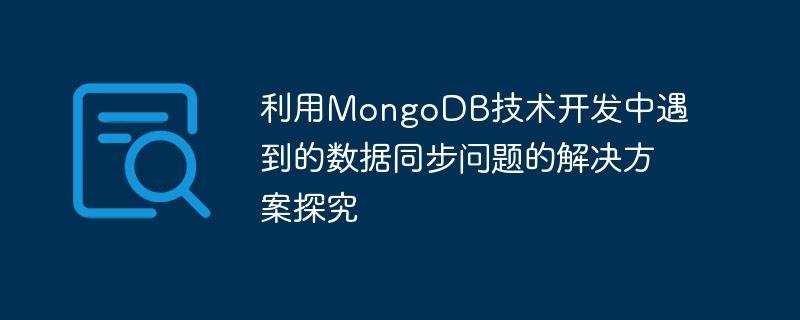Research on solutions to data synchronization problems encountered in development using MongoDB technology
- 王林Original
- 2023-10-08 14:42:311519browse

Title: Research on solutions to MongoDB data synchronization problems
Abstract: With the advent of the big data era, data synchronization problems have become more and more important during the development process. important. This article will explore the data synchronization problems encountered in the development process using MongoDB technology, and propose solutions, as well as specific code examples.
- Introduction
As a popular NoSQL database, MongoDB has become the first choice of developers because of its efficient data storage and query functions. However, during the development process, we often face data synchronization problems. For example, when multiple applications write to or read from a MongoDB database at the same time, inconsistent data may occur. In order to solve these problems, we need to find an effective synchronization strategy.
- Data synchronization problem analysis
When multiple applications write or read the MongoDB database at the same time, the following problems may occur:
- Data conflict: Multiple applications write the same data at the same time, causing conflicts and data loss.
- Data confusion: Reading operations are performed at the same time, resulting in data order confusion.
These issues can result in incorrect status or incorrect output from the application, disrupting the user experience.
- Solution exploration
In order to solve the problem of MongoDB data synchronization, we can adopt the following solutions.
3.1 Using Transactions
MongoDB supports transactions starting from version 4.0. Transactions enable us to combine a set of operations (reads and writes) into one atomic operation, that is, either all of them are executed or none of them are executed. By using transactions we can ensure consistency and isolation. The following code example demonstrates how to use transactions to synchronize MongoDB data:
session.startTransaction();
try {
// 执行数据读写操作
collection1.insertOne(session, document1);
collection2.updateOne(session, filter, update);
session.commitTransaction();
} catch (Exception e) {
session.abortTransaction();
} finally {
session.endSession();
}3.2 Timestamp-based solution
Another solution is timestamp-based data synchronization. Each write operation is marked with a timestamp, and when reading data, the timestamp is checked to determine the new and old order of the data. The following code example demonstrates how to implement timestamp-based data synchronization:
// 写入数据
collection.insertOne(document, new InsertOneOptions().bypassDocumentValidation(true));
// 读取数据
FindIterable<Document> iterable = collection.find().sort(Sorts.ascending("timestamp"));
MongoCursor<Document> cursor = iterable.iterator();
while (cursor.hasNext()) {
Document document = cursor.next();
// 处理数据
}- Conclusion
The data synchronization problem is an important but also common one for MongoDB development challenge. By using transactions and timestamp-based solutions, we can ensure data consistency and sequence. While the choice of solution may vary depending on the specific application, these methods are all effective.
At the same time, we should also delve into MongoDB's document model and query language to better understand and solve data synchronization issues. Only by continuous learning and exploration can we better cope with increasingly complex data synchronization challenges and provide users with better products and services.
References:
- MongoDB official documentation: https://docs.mongodb.com/
- "The Definitive Guide to MongoDB (Second Edition)", Kyle Banker et al., translated by Ni Tao et al., People's Posts and Telecommunications Publishing House, 2015.
(Note: The above code examples are for demonstration purposes only and have not been fully tested. Readers are requested to make corresponding modifications and tests according to their needs in actual applications.)
The above is the detailed content of Research on solutions to data synchronization problems encountered in development using MongoDB technology. For more information, please follow other related articles on the PHP Chinese website!

